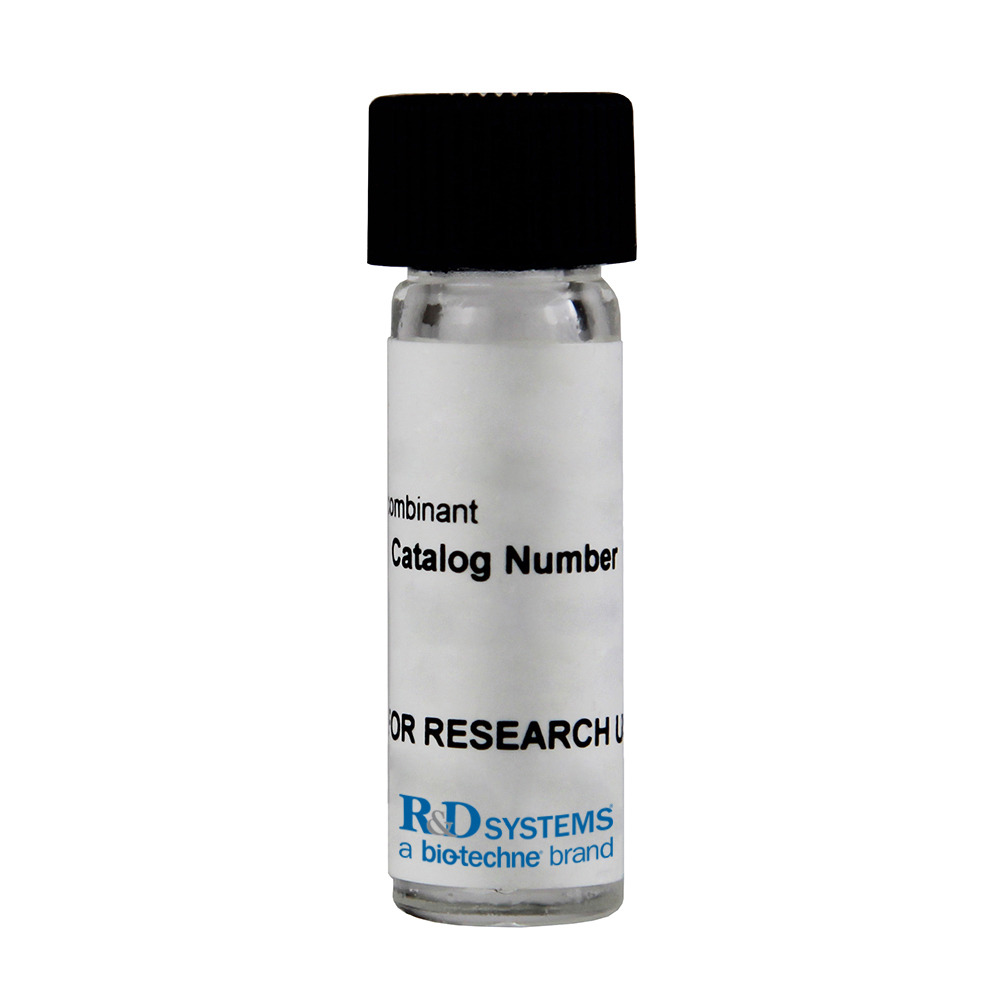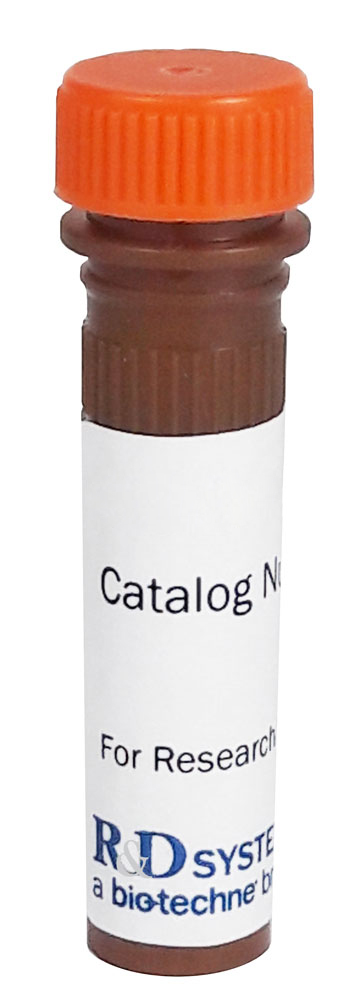Mouse Pentraxin 3/TSG-14 Antibody Summary
Glu18-Ser381
Accession # P48759
Customers also Viewed
Applications
Please Note: Optimal dilutions should be determined by each laboratory for each application. General Protocols are available in the Technical Information section on our website.
Scientific Data
 View Larger
View Larger
Detection of Mouse Pentraxin 3/TSG‑14 by Western Blot. Western blot shows lysates of mouse embryo tissue and NIH-3T3 mouse embryonic fibroblast cell line. PVDF membrane was probed with 0.25 µg/mL of Goat Anti-Mouse Pentraxin 3/TSG-14 Antigen Affinity-purified Polyclonal Antibody (Catalog # AF2166) followed by HRP-conjugated Anti-Goat IgG Secondary Antibody (Catalog # HAF019). A specific band was detected for Pentraxin 3/TSG-14 at approximately 42 kDa (as indicated). This experiment was conducted under reducing conditions and using Immunoblot Buffer Group 1.
Preparation and Storage
- 12 months from date of receipt, -20 to -70 °C as supplied.
- 1 month, 2 to 8 °C under sterile conditions after reconstitution.
- 6 months, -20 to -70 °C under sterile conditions after reconstitution.
Background: Pentraxin 3/TSG-14
Pentraxin 3, also known as TSG-14, was initially identified as a TNF-alpha or IL-1 beta inducible gene (1‑3). It belongs to the pentraxin family, which was named originally for the homo-pentameric structure formed by its members (4). The pentraxin family is divided into two subfamilies: the “short” and the “long” pentraxins with approximate molecular weights of 25 kDa and 50 kDa, respectively. TSG-14 is a member of the long pentraxin subfamily, which also includes the Xenopus laevis XL-PXN1, the guinea pig apexin/p50, the rat neuronal pentraxin I (NPI) and NPR, the human neuronal pentraxin II (NPTX2) and the human neuronal activity-related pentraxin (5).
Mature secreted PTX3 contains a pentaxin-like domain at its carboxy-terminus that shares 23‑28% amino acid (aa) sequence similarity to C-reactive protein (CRP) and serum amyloid P component (SAP), which belong to the short pentraxin subfamily. However, the N-terminal sequence of TSG-14 does not share aa sequence homology with any of the “short” pentaxins (3). Unlike CRP and SAP, which forms pentamers only, TSG-14 forms both pentameric and higher ordered oligomers (5). Similar to CRP and SAP, TSG-14 binds to the complement cascade component C1q (6). However, TSG-14 does not bind to phosphoethanolamine, phosphocholine, or high pyruvate agarose, which are known ligands for CRP and SAP. While CRP and SAP are primarily produced in the liver, TSG-14 expression is strongly up‑regulated by TNF-alpha, IL-1 beta, and bacterial LPS in peripheral fibroblasts, endothelial cells, and macrophages (7). At the amino acid level, human and mouse TSG-14 share 88% aa sequence homology (8). TSG-14 concentration is elevated in the joint fluid of patients with rheumatoid arthritis (RA), indicating that TSG-14 may be a potential mediator of immune response (9). TSG-14 may also function in the regulation of the uptake and clearance of apoptotic cells by dendritic cells (10). An in vivo study showed that TSG-14 transgenic mice are more resistant to sepsis and endotoxemia compared to wild-type during inflammatory injury (11). Increased expression of TSG-14 may enhance the immune response to protect the host from infection.
- Lee, T.H. et al. (1990) Mol. Cell. Biol. 10:1982.
- Breviario, F. et al. (1992) JBC. 267:22190.
- Lee, G.W. et al. (1993) J. Immunol. 150:1804.
- Osmand, A.P. et al. (1977) PNAS, USA 74:739.
- Goodman A.R. et al. (1996) Cytokine & Growth Factor Rev. 7:191.
- Bottazzi, B. et al. (1997) JBC. 272:32817.
- Introna, M. et al. (1996) Blood, 87:1862.
- Altmeyer, A. et al. (1995) J. Biol. Chem. 270:25584.
- Luchetti, M.M. et al. (2000) Clin. Exp. Immunol. 119:196.
- Rovere, P. et al. (2000) Blood 96:4300.
- Dias, A.A.M. et al. (2001) J. Leukocyte Biol. 69:928.
Product Datasheets
Citations for Mouse Pentraxin 3/TSG-14 Antibody
R&D Systems personnel manually curate a database that contains references using R&D Systems products. The data collected includes not only links to publications in PubMed, but also provides information about sample types, species, and experimental conditions.
3
Citations: Showing 1 - 3
Filter your results:
Filter by:
-
Long pentraxin PTX3 is upregulated systemically and centrally after experimental neurotrauma, but its depletion leaves unaltered sensorimotor deficits or histopathology
Authors: M Oggioni, D Mercurio, D Minuta, S Fumagalli, K Popiolek-B, M Sironi, A Ciechanows, S Ippati, D De Blasio, C Perego, J Mika, C Garlanda, MG De Simoni
Scientific Reports, 2021-05-05;11(1):9616.
Species: Mouse
Sample Types: Whole Tissue
Applications: IHC -
The Long Pentraxin 3 Plays a Role in Bone Turnover and Repair
Authors: D Gr?evi?, M Sironi, S Valentino, L Deban, H Cvija, A Inforzato, N Kova?i?, V Katavi?, T Kelava, I Kalajzi?, A Mantovani, B Bottazzi
Front Immunol, 2018-03-05;9(0):417.
Species: Mouse
Sample Types: Whole Cells
Applications: Flow Cytometry -
Pentraxin 3 deficiency exacerbates lipopolysaccharide-induced inflammation in adipose tissue
Authors: Hong Guo, Xiaoxue Qiu, Jessica Deis, Te-Yueh Lin, Xiaoli Chen
International Journal of Obesity
FAQs
No product specific FAQs exist for this product, however you may
View all Antibody FAQsIsotype Controls
Reconstitution Buffers
Secondary Antibodies
Reviews for Mouse Pentraxin 3/TSG-14 Antibody
There are currently no reviews for this product. Be the first to review Mouse Pentraxin 3/TSG-14 Antibody and earn rewards!
Have you used Mouse Pentraxin 3/TSG-14 Antibody?
Submit a review and receive an Amazon gift card.
$25/€18/£15/$25CAN/¥75 Yuan/¥2500 Yen for a review with an image
$10/€7/£6/$10 CAD/¥70 Yuan/¥1110 Yen for a review without an image
















